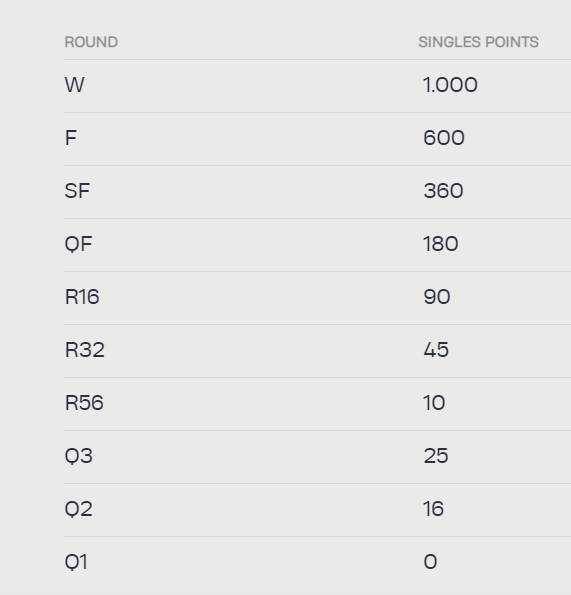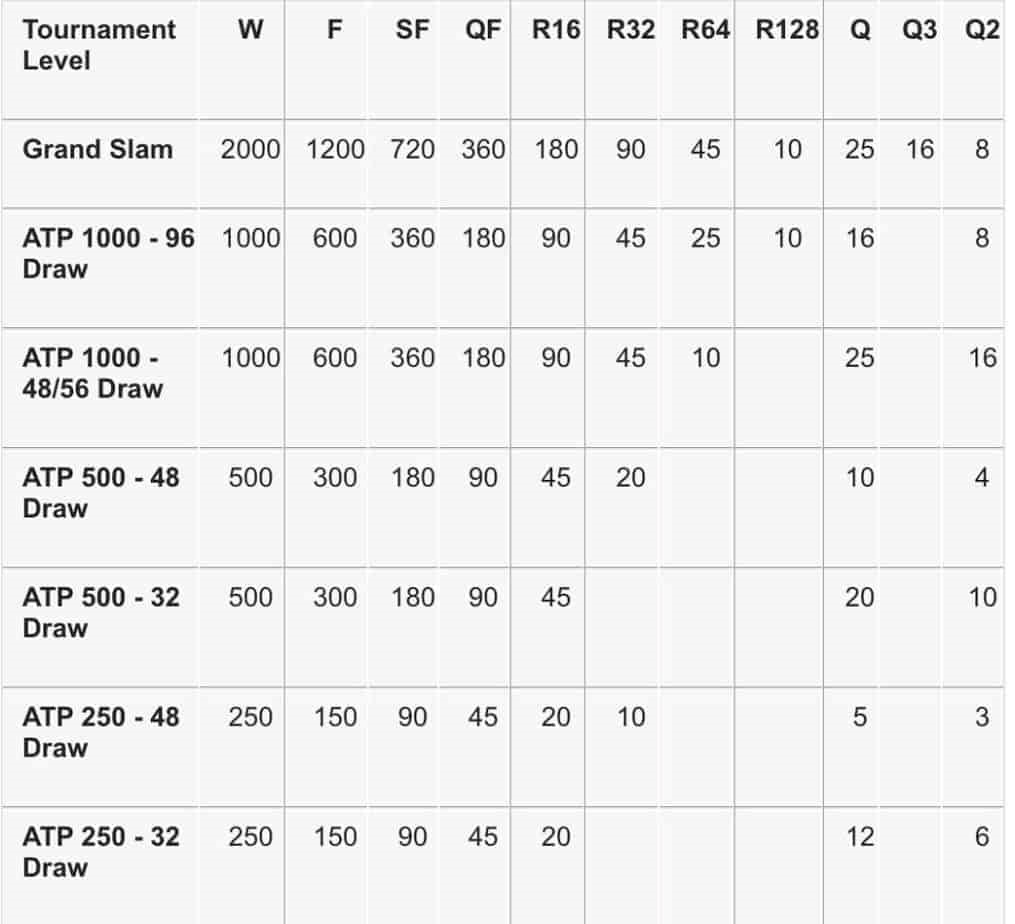What is ATP and WTA in Tennis?
ATP (The Association of Tennis Professionals) and WTA (The Women’s Tennis Association) are the two governing bodies for men’s and women’s tennis. They are most known for organizing tournament and being the official source for ranking the top men and women tennis players in the world.
The ATP organizes and oversees all ATP tournaments, including ATP Masters 1000, ATP 500 and ATP 250 tournaments. The ATP also organizes the ATP Challenger Tour, which is a tour for lesser accomplished players.
Along with the ATP and WTA, the third association that deals with all aspects of professional tennis is the ITF (International Tennis Federation). The ITF is the governing body of tennis and determines the official rules of tennis. The ITF also organizes the 4 Grand Slam tournaments.

How Do Tennis Players Earn Ranking Points on the ATP and WTA?
The tennis season lasts throughout the year and during the year the aforementioned associations organize a large number of tournaments that are ranked by the strength of the tournament. Each tournament is allocated a number of points that winner will receive.
For instance, the Grand Slam tournaments award the most points of any tournaments, where 2000 points are awarded to the men’s and women’s winner of each tournament.
The men’s winner of the Italian Open, which is currently taking place receives 1,000 points. Here are the number of points each men’s player receives for participation in the Masters 1000 Italian Open.

After the Grand Slams, the ATP Masters 1000 and WTA 1000 tournaments are the next most valuable tournaments, the winners of which win 1000 points. They are followed by ATP 500 and 250 tournaments and WTA 500, 250 and 125 tournaments.
In each of these tournaments, the players in each of the rounds win the number of points provided for that tournament. On the ATP tour, there is also a season-ending Nitto ATP Finals, in which the top 8 players from the current year are invited and the winner can win up to 1,500 points.

Based on the number of points players win at these tournaments over the prior 52 weeks, they are ranked on the ATP and WTA rankings. Tournaments older than 52 weeks ago, drop off a player’s ranking and are replaced by new tournaments.
As an example, if a player wins Wimbledon, he will receive 2,000 points. The following year, at Wimbledon, if the same player is eliminated in the first round, the player’s 2,000 points from the prior year are erased and are replaced by the number of points the player won in the new year, which is just 10 points for a first-round loser.
I previously explained this in detail in an article explaining how Djokovic re-took the #1 ranking without even playing.
One criticism that I often hear about this ranking system is that it does not award or penalize a player based on the quality of the opposing player. For instance, in an extraordinary upset, the 135th player in the world, Fabian Maroszan, just defeated Carlos Alcarez.
He received the same number of points for this win as he would have won if he defeated a much lower ranked player. The UTR, on the other hand, does take into account the relative strength of weakness of an opposing player, so Maroszan’s UTR will increase, and increase more than if he beaten a lessen ranked player.
ATP Rankings
So, how exactly are ATP rankings calculated and which matches are included in the calculation? The ATP includes results from the 19 tournaments in any 52-week period, and 20 tournaments for those players fortunate to earn a spot in season-ending Nitto ATP Finals.
These 19 tournaments include the 4 Grand Slams, 8 Masters 1000 tournaments, and the seven best other tournaments. The following comes from the ATP website which explains this as follows:

The player who wins the most cumulative points in any 52-week period will be at the top of the ATP rankings. Here is the breakdown for how many points each player wins in every category of tournament.

Source: ITF World Tour
WTA Rankings
So, how exactly are the WTA rankings calculated and which matches are included in the calculation? The results achieved in the WTA are ranked in a similar fashion as the ATP.
Depending on the tournament category, players win a certain number of points in each of the rounds in those tournaments. However, there are certain differences between the ATP and WTA rankings.
As stated on the WTA website, a “player’s ranking is determined by her results at a maximum of 16 tournaments for singles and 11 for doubles.” Just as with the men, the WTA has a season-ending 17th tournament, called the WTA Finals, for those players that qualify.
One difference in the WTA is that the WTA has 2 kinds of WTA 1000 tournaments, mandatory and non-mandatory tournaments. The mandatory tournaments award the winner 1,000 points and the non-mandatory tournaments award the winner 900 points. Similarly, the winner of a WTA 500 event wins 470 points, the winner of a WTA 250 wins 280 points, and the winner of a WTA 125 wins 160 points.
To have a ranking, a player must earn points in at least three tournaments or win at least 10 points in a single tournament.
ATP and WTA Rankings History
As for singles, the ATP rankings started in 1973. Three years later, the same thing was done in doubles. Players quickly accepted this scoring system, although some players rebelled against the ATP rankings. One of them was the famous Romanian player and former world #1, Ilie Nastase, who then complained that “everyone had a number hanging over them”.

Ilie Nastase
The last changes to the ATP rankings system were made at the beginning of this century when the current scoring system was established.
Like the ATP, WTA rankings have been around since the 1970s, with the WTA being established in November, 1975.

Current ATP and WTA #1 – Novak Djokovic and Iga Swiatek
Credits: Sportskeeda
Fun Facts
Novak Djokovic holds the record for the most number of weeks spent in first place in the ATP rankings, which currently stands at 387 weeks. He ended the calendar year 7 times in the #1 position, which is also a record.
Since 1973, when the ATP rankings were established, there have been a total of 28 players to be ranked #1 in the world. Ilie Nastase was the first to do so.
Roger Federer holds the record for the most consecutive weeks at the top spot, at 237 weeks, which he held from February 2004 to August 2008. Pete Sampras holds the record for finishing at the top of the ATP rankings for six years in a row.

Novak Djokovic – Most Weeks as World No.1
For the women, just like the men, there have coincidentally also have been 28 players to be ranked #1 in the world since the WTA rankings were introduced in 1975. Chris Evert was the first #1 ranked player.
Steffi Graf holds the record for the most weeks ranked #1, at 377 weeks. She, along with Serena Williams, holds the record for the number of consecutive weeks at number one, which is 186.

One final fun fact: The computerized system that scores players in both competitions has nicknames. For men, the computer’s nickname is “Blinky.” For women, the computer that calculates the rankings is known as “Medusa.”






